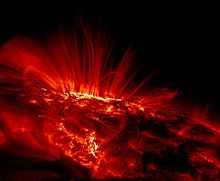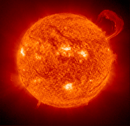TRACE
TRACE (Transition Region And Coronal Explorer) was a NASA space telescope designed to investigate the connections between fine-scale magnetic fields and the associated plasma structures on the Sun by providing high resolution images and observation of the solar photosphere and transition region to the corona. A main focus of the TRACE instrument is the fine structure of coronal loops low in the solar atmosphere. TRACE is a SMEX or SMall EXplorer mission, launched in 1998 and obtaining its last science image in 2010.[1]
The satellite was built by NASA's Goddard Space Flight Center. Its telescope was constructed by a consortium led by Lockheed Martin's Advanced Technology Center. The optics were designed and built to a state-of-the-art surface finish for the period, by the Smithsonian Astrophysical Observatory (SAO) in Cambridge MA. TRACE was launched in April 1998 on a Pegasus rocket, has a 30 cm aperture and 1024 x 1024 CCD detector giving an 8.5 arc minute field of view. The telescope is designed to take correlated images in a range of wavelengths from visible light, through the Lyman alpha line to far ultraviolet. The different wavelength passbands correspond to plasma emission temperatures from 4,000 to 4,000,000 K. The optics use a special multilayer technique to focus the difficult-to-reflect EUV light; the technique was first used for solar imaging in the late 1980s and 1990s, notably by the MSSTA and NIXT sounding rocket payloads.
Image gallery
-
TRACE image of some typical million Kelvin loops
-
-
TRACE mosaic of the full-disk Sun
See also
References
External links
|
|---|
| | Current | |
|---|
| | Planned | |
|---|
| | Proposals | |
|---|
| | Completed | |
|---|
| | Lost | |
|---|
| | Completed |
- hibernating after mission: SWAS (1998–2005)
- TRACE (1998–2010)
|
|---|
| | On hiatus | |
|---|
| | Cancelled | |
|---|
| | See also | |
|---|
|
 Category Category
|
|
|
|---|
| | Current | | |
|---|
| | Past | |
|---|
| | Planned | |
|---|
| | Cancelled | |
|---|
| | Sun-Earth | |
|---|
|
|
|---|
| Lunar Prospector | Skynet 4D | Ofek-4 | STS-89 | Soyuz TM-27 | USA-137 | Brasilsat B3 · Inmarsat-3 F5 | Orbcomm FM3 · Orbcomm FM4 · GFO · Ad Astra | Globalstar 1 · Globalstar 2 · Globalstar 3 · Globalstar 4 | Kosmos 2349 | Iridium 50 · Iridium 52 · Iridium 53 · Iridium 54 · Iridium 56 | Kakehashi | SNOE · Teledesic 1 | Hot Bird 4 | Intelsat 806 | Progress M-38 (VDU-2) | USA-138 | SPOT 4 | Iridium 51 · Iridium 61 | Iridium 55 · Iridium 57 · Iridium 58 · Iridium 59 · Iridium 60 | TRACE | Iridium 62 · Iridium 63 · Iridium 64 · Iridium 65 · Iridium 66 · Iridium 67 · Iridium 68 | STS-90 | Globalstar 6 · Globalstar 8 · Globalstar 14 · Globalstar 15 | Nilesat 101 · BSat-1B | Kosmos 2350 | Iridium 69 · Iridium 71 | Kosmos 2351 | EchoStar IV | USA-139 | NOAA-15 | Progress M-39 | Iridium 70 · Iridium 72 · Iridium 73 · Iridium 74 · Iridium 75 | Zhongwei 1 | STS-91 | Thor 3 | Kosmos 2352 · Kosmos 2353 · Kosmos 2354 · Kosmos 2355 · Kosmos 2356 · Kosmos 2357 | Intelsat 805 | Kosmos 2358 | Kosmos 2359 | Molniya 3-49 | Nozomi | Shtil-1 · Tubsat-N · Tubsat-N1 | Resurs-O1 #4 · Fasat-Bravo · TMSAT · Gurwin Techsat 1B · WESTPAC · SAFIR-2 | Sinosat-1 | Kosmos 2360 | Orbcomm FM13 · Orbcomm FM14 · Orbcomm FM15 · Orbcomm FM16 · Orbcomm FM17 · Orbcomm FM18 · Orbcomm FM19 · Orbcomm FM20 | Mercury 3 | Soyuz TM-28 | Iridium 3 · Iridium 76 | ST-1 | Galaxy 10 | Astra 2A | Kwangmyŏngsŏng-1 | Iridium 77 · Iridium 79 · Iridium 80 · Iridium 81 · Iridium 82 | Globalstar 5 · Globalstar 7 · Globalstar 9 · Globalstar 10 · Globalstar 11 · Globalstar 12 · Globalstar 13 · Globalstar 16 · Globalstar 17 · Globalstar 18 · Globalstar 20 · Globalstar 21 | PAS-7 | Orbcomm FM21 · Orbcomm FM22 · Orbcomm FM23 · Orbcomm FM24 · Orbcomm FM25 · Orbcomm FM26 · Orbcomm FM27 · Orbcomm FM28 | Molniya-1T #99 | STEX (USA-141) | Eutelsat W2 · Sirius 3 | Hot Bird 5 | USA-140 | Maqsat 3 | Deep Space 1 · SEDSAT-1 | Progress M-40 ( Sputnik 41) | AfriStar · GE-5 | STS-95 (SPARTAN-201 · PANSAT) | PAS-8 | Iridium 2 · Iridium 83 · Iridium 84 · Iridium 85 · Iridium 86 | Zarya / ISS | Bonum 1 | STS-88 ( Unity · PMA-1 · PMA-2 · SAC-A · MightySat-1 | Satmex 5 | SWAS | Nadezhda 5 · Astrid 2 | Mars Climate Orbiter | Iridium 11 · Iridium 20 | PAS-6B | Kosmos 2361 | Kosmos 2362 · Kosmos 2363 · Kosmos 2364 | | Payloads are separated by bullets ( · ), launches by pipes ( | ). Manned flights are indicated in bold text. Uncatalogued launch failures are listed in italics. Payloads deployed from other spacecraft are denoted in brackets. |
|




